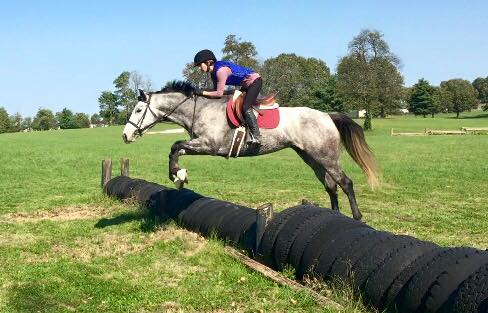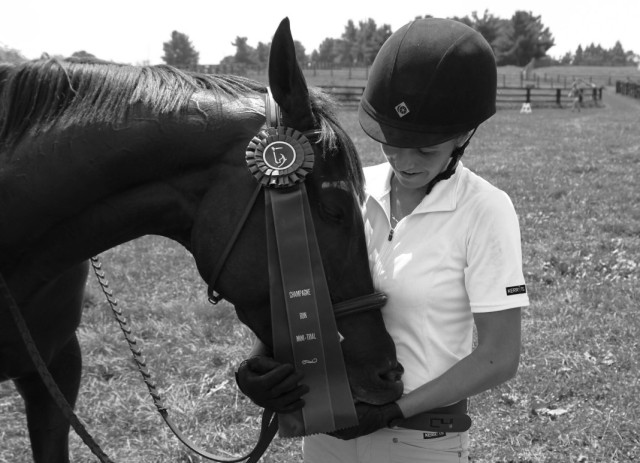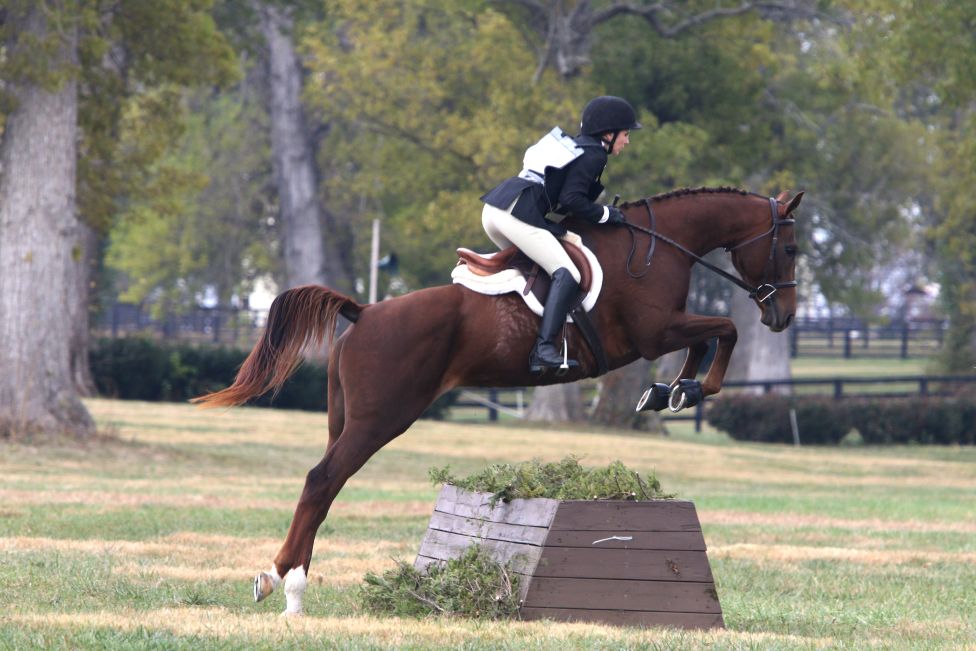 Ripley (Now Bella), a warmblood X TB mare I raised and sold as an eventer. Currently going Training Level. Photo courtesy of Lindsay Gilbert.
Ripley (Now Bella), a warmblood X TB mare I raised and sold as an eventer. Currently going Training Level. Photo courtesy of Lindsay Gilbert.
So, you’ve decided to embark upon the process of finding a mount, a competitor, an athlete, a partner.
This part is hard for me. I am the type of person to never turn away a horse. Bad conformation, vices, untouched for years, it didn’t matter. I could see the potential in anything, I could find a career or a future for whatever came my way.
But this time, it’s different. I have to search for a mount with eventing potential and one that I can uncover that potential in a matter of months. So what in the world am I going to look for? Do I want a war horse who has proven themselves on the track time and time again, or do I want a youngster with very few starts who is a clean slate? It’s time for me to sit down and decide what I need and what I want in an RRP prospect.
First, I need to think about the job that I’m asking my new partner to do. My sport of choice this year is eventing, a combination of dressage, stadium jumping and cross country. I need a horse with nice, relaxed gaits for dressage, a careful ability over fences who will leave rails up in stadium and the heart to gallop over any obstacle a cross country course designer will throw our way.

Patriot, a Saddlebred gelding given to me sight unseen, found his calling in dressage! Photo courtesy of Lindsay Gilbert.
So many Thoroughbreds have excelled in eventing because of their heart and ability to gallop. But there are a few things I look for when selecting a horse for the sport of eventing.
- Soundness: The very first thing the horse must be is sound. I cannot, in good conscience, ask a horse to gallop and jump that is not comfortable doing so. So I will look for a horse who jogs freely, that tracks up nicely (meaning the hind feet fall in the hoof print of the front foot) and who has a nice, swinging gait. I will look for a horse with no heat or swelling in the legs or feet and who has few, if any blemishes or “track jewelry” which could inhibit their longevity in a sport that tests a horse to the fullest.
- Conformation:
- I like a horse with good overall proportion meaning the horse is made up of 1/3 shoulder, 1/3 barrel, 1/3 hindquarters.
- I look for a powerful hind end, and a long, upright shoulder that is tied in above the chest. My ideal horse will have a deep chest that will allow them to gallop for long periods of time and breathe freely as they’re doing so.
- Lastly, my partner should have straight legs that are well set, meaning the front legs show a straight line from the shoulder, through the knee and ending right at the heel of the hoof, with a nicely angled pastern that is identical to the slope of the hoof, if possible. The front legs carry the majority of the horse’s weight, so they are of utmost importance, but hind legs are also key because they are what propels the horse forward, and for jumping, upward. The hind legs, from behind, should be straight from the buttocks to the hoof, with the hocks and rear hooves equal distance apart. From the side, there should be a straight line from under the buttocks, down the back of the cannon bone to the ground, a few inches behind the heel.
- Personality: Most horses can overcome flaws in conformation by sheer heart alone. The horse has to love it’s job and want to work. But I, for one, rarely ride the OTTBs I see before I purchase them. So, it’s hard to determine heart before you get the horse home and start introducing them to their new life. Yet, I do look for a few key things.
- Kind Eye. In a situation with time constraints, like the RRP, it is imperative that the mount you choose be trainable. I always look for a horse with a kind eye, who shows a sense of understanding and a level of relaxed thinking. These horses are better able to take things in stride without becoming overwhelmed and uneasy.
- Forward Thinking. For eventing, the horse must possess a sense of forwardness. The last thing I want when galloping cross country is to be exerting all my energy just trying to get the horse to GO! Additionally, a more forward-thinking horse is more likely to take me to the fence and help me out of a bad situation rather than refusing a fence because the bravery and forward momentum was lacking.
- Relaxed. Having touched on relaxed thinking when talking about a kind eye, there is also the element of a relaxed body. I like a horse who does not generally carry tension in its muscles. Muscle tension can be a sign of anxiety or nervousness which can then manifest itself in “explosive behavior” such as rearing, bucking, taking off and other scary tactics.
There are several other factors to consider when purchasing a prospect, but I won’t bore you with every single detail. As I comb through the hundreds, if not thousands, of OTTB sale ads I come across on a daily basis, these general principles will guide my way and, hopefully, land me an eventing machine!
Lindsay is the owner of Transitions Sport Horses, based in Lexington, Kentucky. She participated in the 2016 Retired Racehorse Project Thoroughbred Makeover on Rebel Annie and is back again in 2017 with Hot Java. Keep up with their journey here on EN and via her blog, Making It to the Thoroughbred Makeover!
































